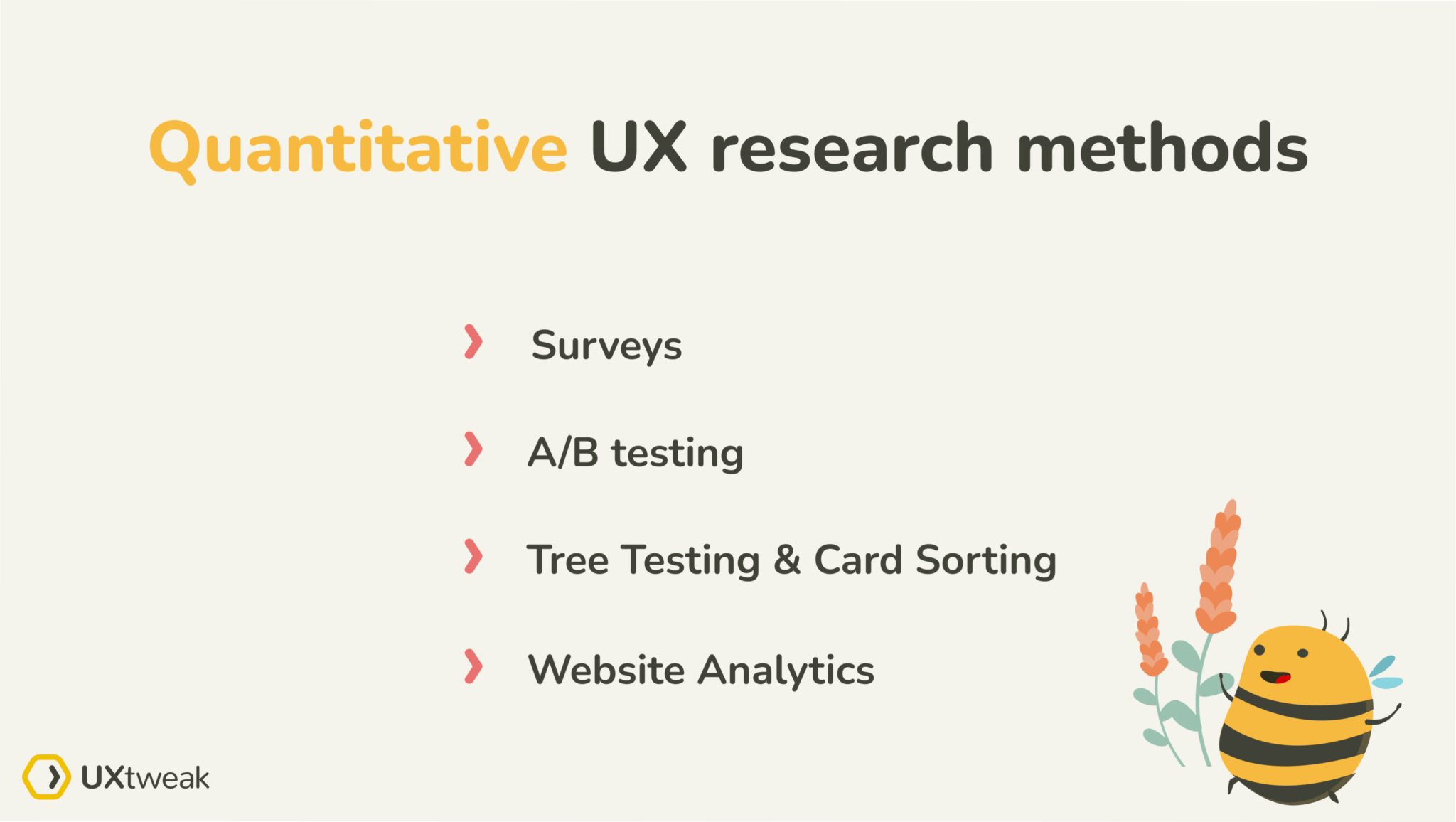In UX design, it is important to keep the user and their needs in mind at all stages of the design process. But still, how can you know what your users’ needs are? The best way to find out is to conduct thorough user research and collect enough data. Today we are going to give you the quantitative vs. qualitative research comparison and show when to use which method.
While there isn’t one that is better or more valuable than the other, there are some key differences that make qualitative data at times more useful than quantitative data—and vice versa.
What is qualitative research?
Qualitative UX research focuses on a smaller number of users to understand their needs in greater detail. The goal of qualitative research is to discover any problems in UX, investigate why something is happening, or find ways to solve a particular issue. This type of research answers questions like: “Why?” or “How?”
When you want to know why users are having a bad experience with your product, listen to their opinions and find out more about the reasons behind their behavior – qualitative research methods are the ones to help you! Qualitative research is often formative, meaning that it helps you get the understanding you need to make the right creative decisions.
What is quantitative research?
Quantitative research focuses on large groups of people to collect data that can be counted or measured with numerical responses. Quantitative research is used to determine the scale of a problem, evaluate design possibilities, or track a product’s user experience over time. This type of research frequently provides answers to such questions as “How many?” and “How much?” and provides you with statistical data.
When you want to discover how many users feel a certain way about a product or its specific features, conduct quantitative research.
Qualitative UX research pros and cons
Advantages
- It’s a flexible research method since you can change your questions, refocus the discussion based on the user’s responses, or add additional depth to the questions you’re asking.
- Because of the nature of the questions posed in qualitative research, you can get more detailed feedback and thus a better understanding of what a user thinks and why they think that way.
- Users can provide you with nonverbal clues that can help you further your research. Qualitative research methods allow researchers to delve into the emotional data that influences decision-making.
- The study’s findings may challenge your assumptions about the product by revealing an entirely different outcome than you may have anticipated. Participants tend to offer more information than you expect.
- There is no “right” or “wrong” answer because it is an open-ended process, which makes data collection much easier.
Disadvantages
- Varying user feedback might make it harder to reach a conclusion. Because individuals have different perspectives, the reaction to qualitative research findings can often be at two extremes. That means two very different outcomes can be achieved, making the data difficult to analyze and present to generalized audiences.
- The qualitative research method does not allow for statistical analysis. It will only present the study’s findings from a variety of perspectives. Responses to this type of research can be challenging to represent statistically.
Quantitative UX research
Advantages
- Quantitative research uses a larger sample size, allowing you to learn more about your users and enhance the research’s credibility. When you have the option of researching a larger sample size for any hypothesis, it is easier to acquire an accurate generalized conclusion.
- It is a straightforward process to implement, thereby allowing researchers to collect information quickly from a large number of participants.
- The type of findings you get when collecting quantitative data will help you decide on the type of statistical analysis you should do. As a result, evaluation of your data and presenting your conclusions becomes simple and free of subjectivity and errors.
Disadvantages
- Quantitative research often does not allow for in-depth feedback; most questions will have responses drawn from a set of multiple-choice answers. If the questions are not well-formulated, then you might miss out on critical insights.
- There’s a chance that the responses or characteristics provided aren’t representative of the entire population. Because of the assumptions and generalizations that are required for this activity, it is relatively easy to arrive at incorrect conclusions.
- While quantitative research can tell you how many people did a specific action, or which features they favor, it can’t tell you the reasons for their actions or choices.
Qualitative vs quantitative UX research: Which one is better?
Overall, no single research method will be able to provide you with answers to all of your questions. Using a range of methodologies in your research is the greatest plan. Both qualitative and quantitative research play an important role in the design process and also provide us with different kinds of information from users. By combining the two, you’ll get the best of both worlds and obtain the most accurate assessment from your research.
Below, we list some typical qualitative and quantitative UX research methods. We say typical since a specific research method isn’t strictly bound to one type. Rather, the type is just one of several aspects of the research method. Some methods are more likely to be one type rather than the other. Sometimes, a research method even combines aspects of multiple types, making it a hybrid.
For example, usability testing may collect qualitative insights about why participants fail to complete a key goal in a web application. But an unmoderated usability testing study conducted online with enough respondents to be statistically significant can also help you tell how much of a problem this actually is.
Typical qualitative UX research methods:

- User interviews
- Focus groups
- Usability testing
- Five second testing
- Session recording
- Field studies
- Diary studies
Interviews
This method is used to collect in-depth information on people’s opinions, beliefs, experiences, and feelings. Interviews can be conducted one-on-one or in a group context, such as a focus group, and can be done in person or remotely via video call.
Focus groups
Involves a discussion in a small group (usually 5-10 participants) with a moderator guiding the discussion. The aim is to learn more about users’ beliefs, thoughts, impressions, desires and reactions to certain concepts.
Usability testing
A process of evaluating a product or service by putting it to the test with real users and giving them tasks to complete. Usability testing can be moderated or unmoderated, and it can be done in person (e.g., in a lab) or remotely (e.g., through video call). Check out this article on how to run usability tests.
Five second testing
Five-second testing is a quick usability testing method that involves showing participants a design or interface for just five seconds and then asking them questions about their initial impressions.
Session recording
A full recording of a user’s session – of interacting with a product. Allows researchers to observe every scroll, click and other interaction with a digital product and gain insights about user behavior.
Field studies
A field study in UX means observing and gathering qualitative data from real users in their natural environment, such as their homes or workplaces. The goal is to understand their behaviors, needs, and challenges in order to inform and improve digital product design.
Diary studies
Diary studies involve collecting data from users over an extended period of time, typically through entries in a diary or journal. These studies provide rich, in-context information.
Typical quantitative UX research methods:

- Card sorting
- Tree testing
- A/B testing
- Five second testing
- First click testing
- Website analytics
- Surveys
- Eye-tracking studies
Card Sorting
Card sorting is a UX research method in which study participants organize topics into categories that make sense to them. This method serves to create an information architecture that matches users’ expectations. Check out this article on how to conduct a card sort.
Tree testing
Tree testing is a technique that involves removing the user interface and requiring users to navigate the site and perform tasks solely through links. This allows you to determine whether a problem is caused by the user interface or the information architecture.
A/B testing
A/B testing involves putting two or more versions of your design to the test on users to see which one is the most effective. Each variation differs only in one aspect, which may or may not influence how users react. A/B testing is particularly useful for confirming assumptions derived from qualitative research.
First click testing
Involves observing where participants would click first on a user interface when asked to accomplish a certain task. This method helps identify potential usability issues and provides insights into users’ expectations and mental models of the interface.
Website Analytics
Using analytical tools like Google Analytics and UXtweak to measure metrics, such as page views and click-through rates, gives you a better understanding of your user’s behavior. Check out this list of the best tools you can use for website analytics.
Surveys
A popular approach for gathering quantitative data is by having users fill out a series of questionnaires. Surveys are typically used for quantitative research, but they can also be used for qualitative research when structured properly. Here you can find additional information on what surveys are and how to conduct them effectively.
Eye tracking
Uses specialized technology to track and record users’ eye movements as they interact with digital interfaces, providing insights into visual attention and helping designers optimize the design and placement of elements within the interface.
How to perform data analysis
Both qualitative and quantitative research approaches supply researchers with a wealth of information. Once the study is over, it’s time to analyze the information gathered to gain relevant insights from it. Here’s how you can analyze UX research data.

1. Organize and collect your research data logically
This comprises the information from all sources and formats, including text, handwritten notes, audio recordings, and video clips. To effectively analyze your audio and video clips, make sure to transcribe them.
2. Tag and code your data
Review the notes, transcripts, and data for any relevant phrases, statements, and concepts that correspond to the research goals and questions. Review the tag and code any remaining data that represents key activities, actions, concepts, statements, ideas, and needs or desires from the customers who participated in the research.
3. Identify common themes
Examine the tags and codes to see if any connections can be used to determine themes. Pay particular attention to tags that include notes with several other tags as a helpful tip. This frequently suggests a connection between subjects. You may also use Affinity Diagrams to visualize your data and uncover meaningful patterns. Here you can find more information on using thematic analysis to analyze qualitative data.
4. Synthesize data by turning your themes into meaningful insights
Depending on your study goals, you’ll work your way through each theme, starting with the ones you think are most important. This can be done on a whiteboard with sticky notes with each theme linked to a study discovery and the final insight gained. Once you’ve finished, make a list of all of the most important insights.
5. Present your findings
Sharing your findings with your team is the final stage in the analytical phase. Create a UX Research report on your findings and recommendations. The insights you uncover through user research and subsequent analysis will guide the next steps in your design process, indicating what you should focus on and why.




